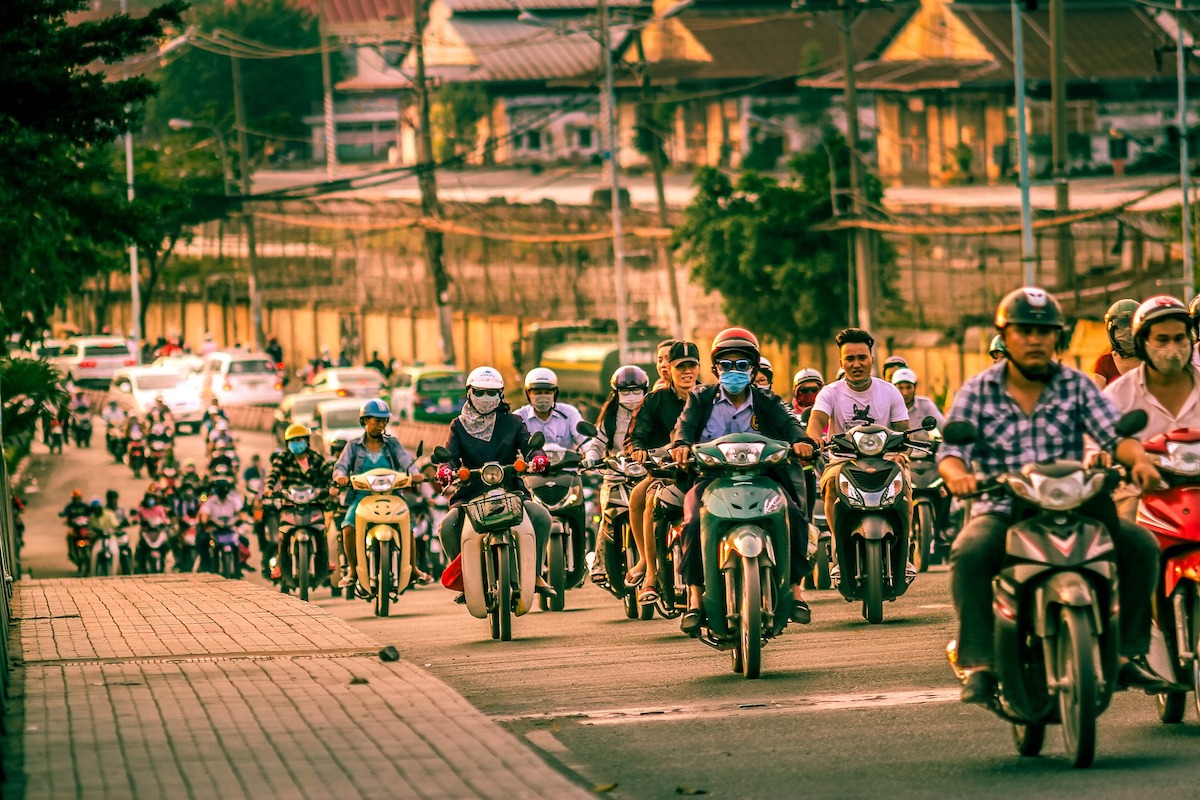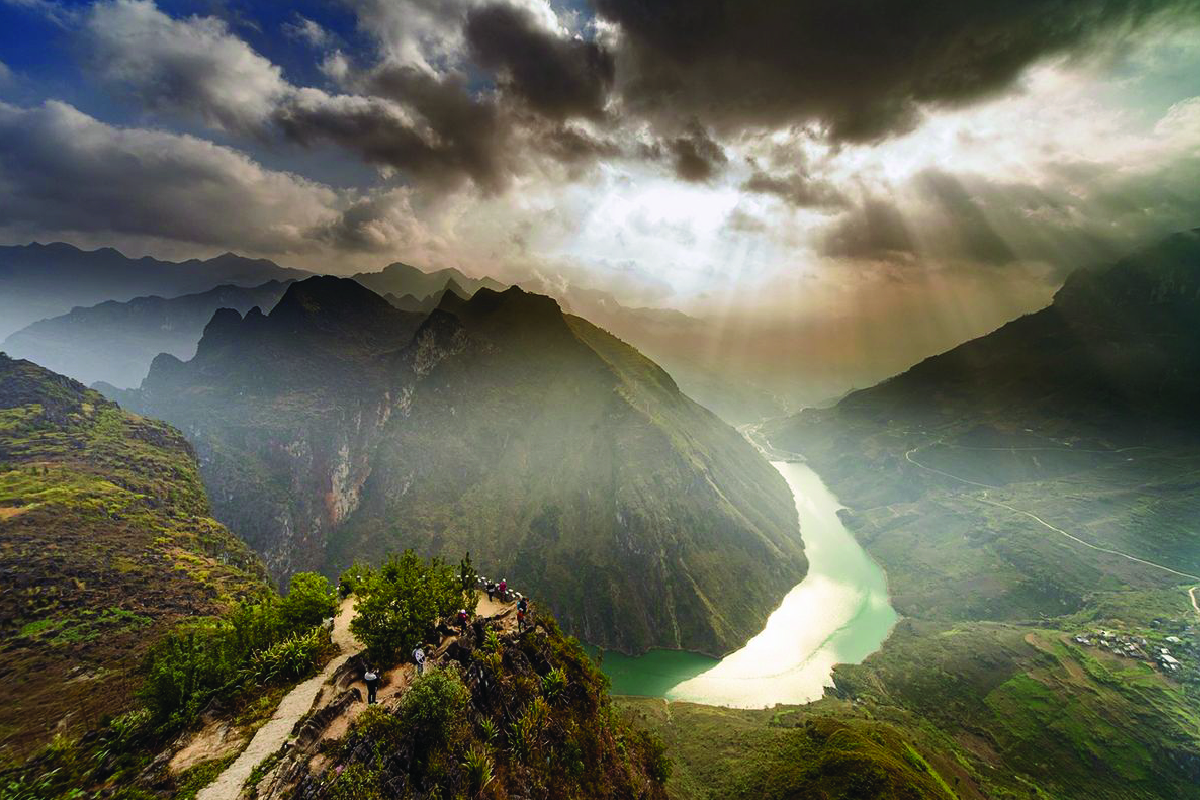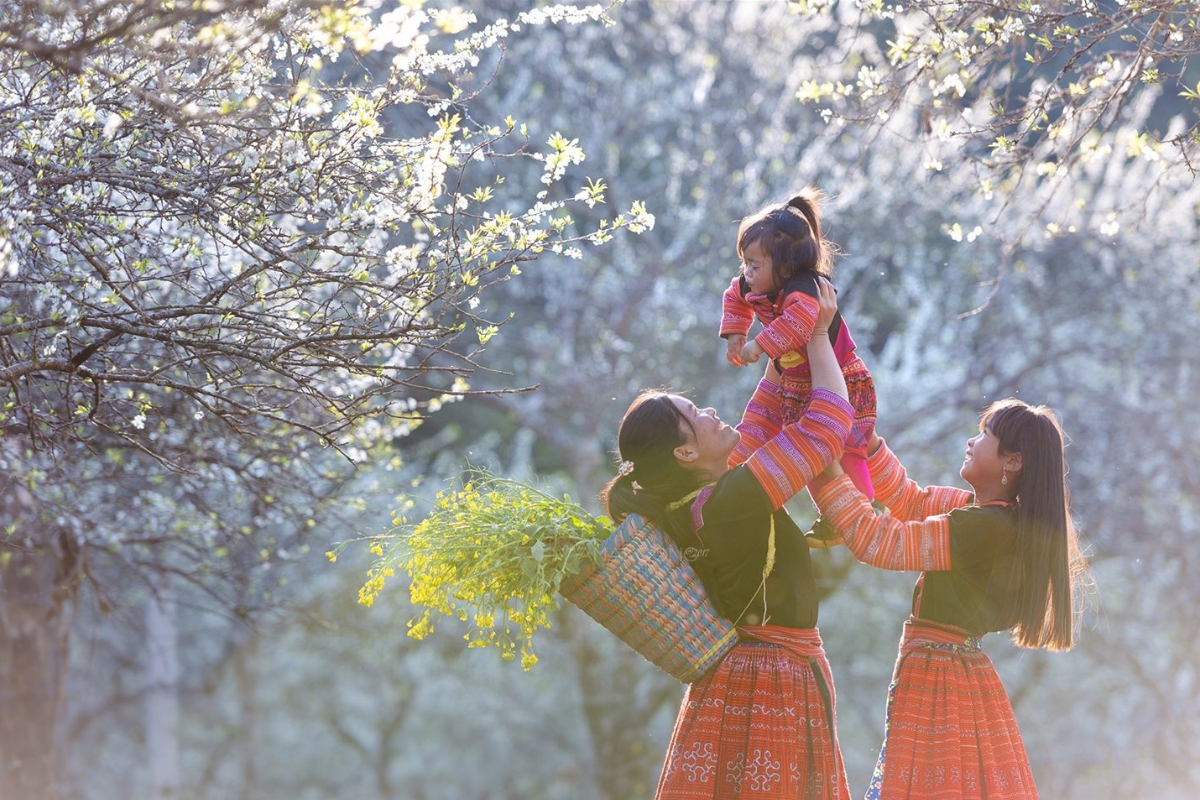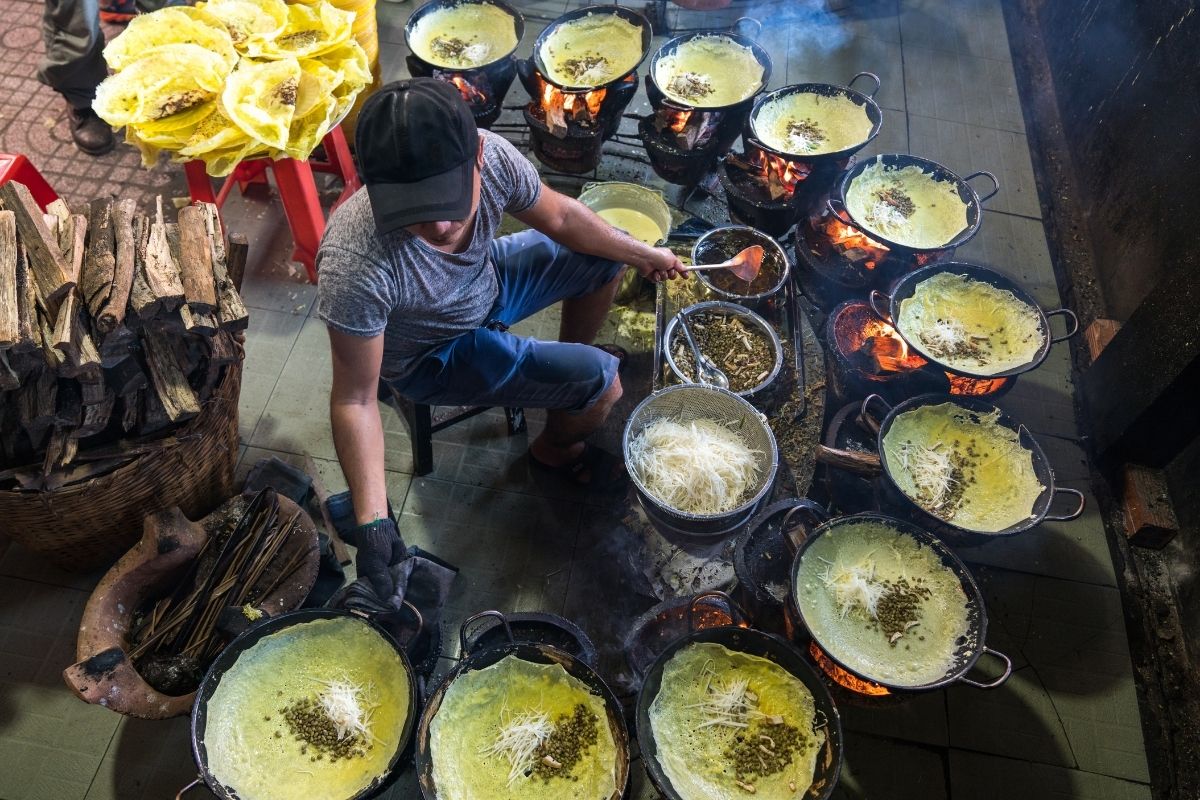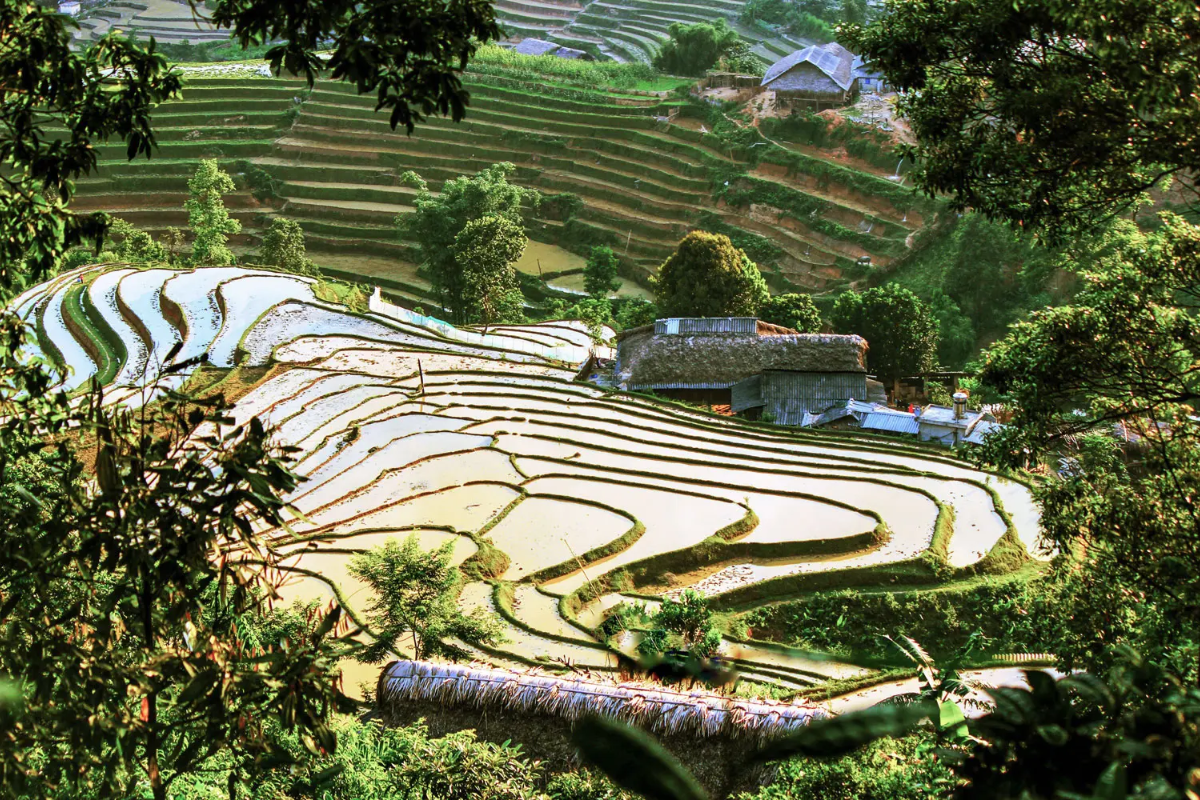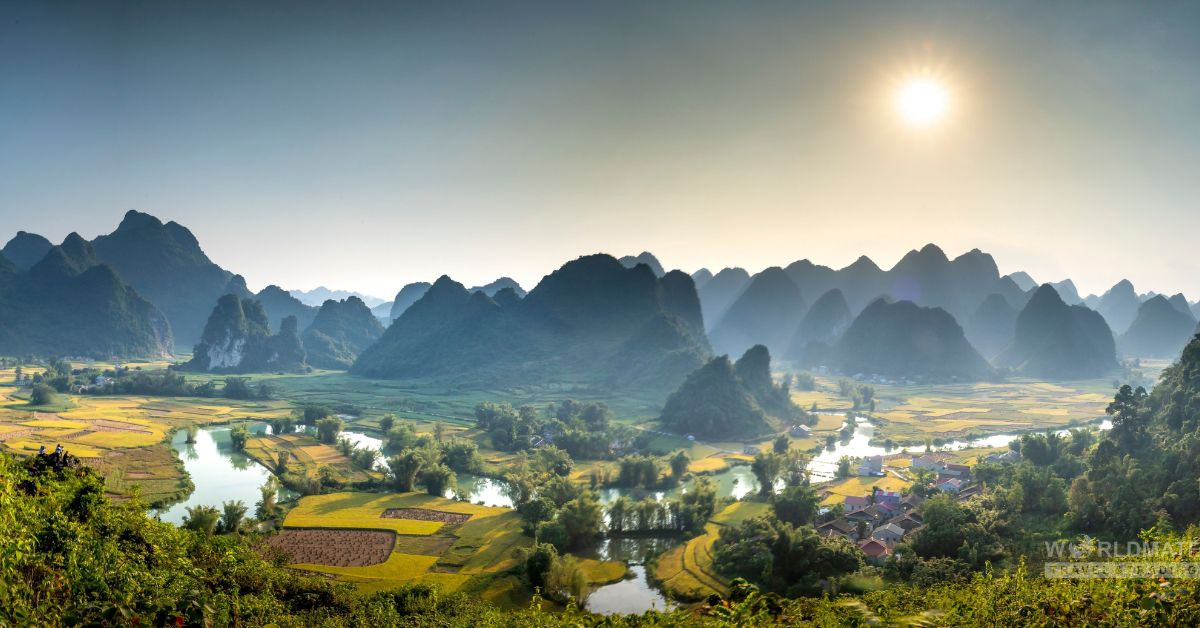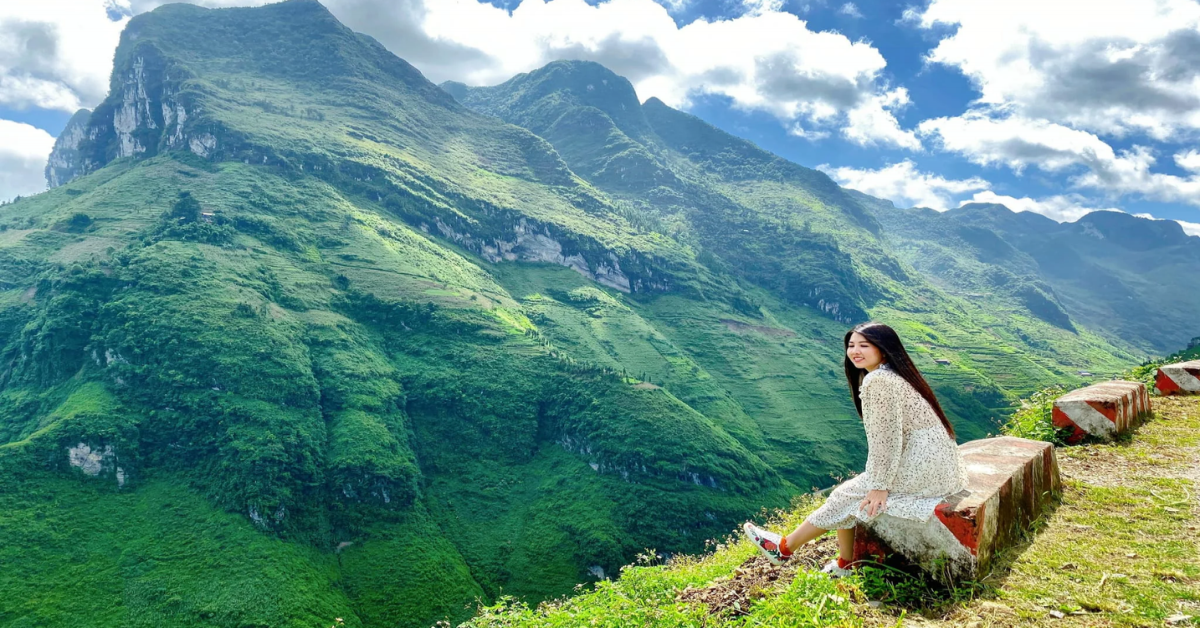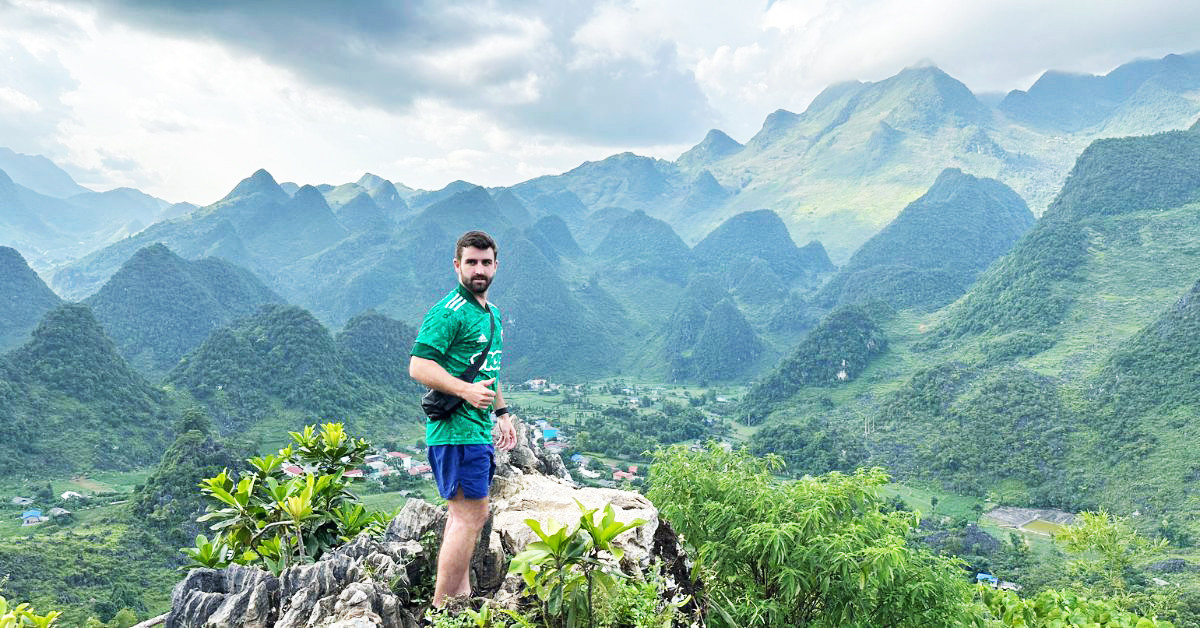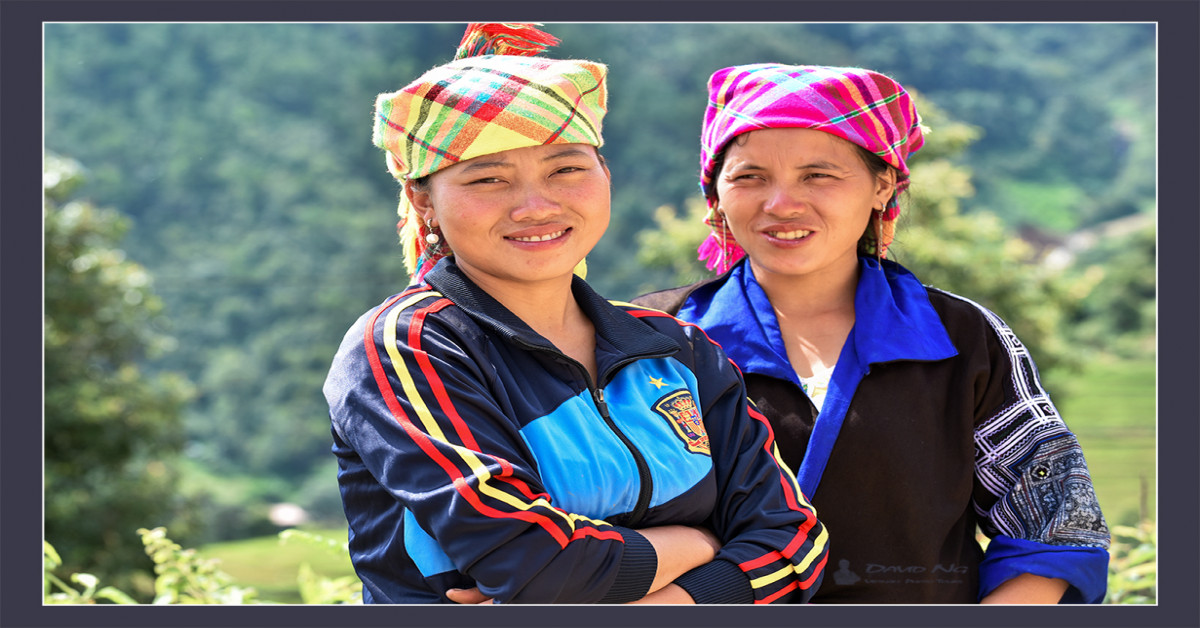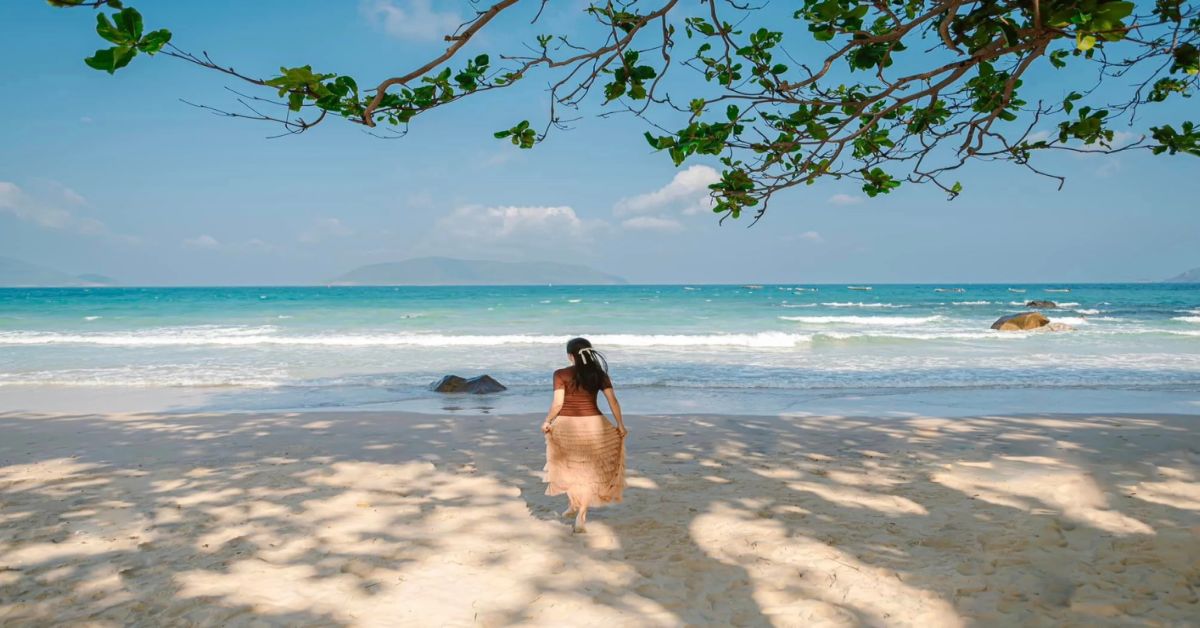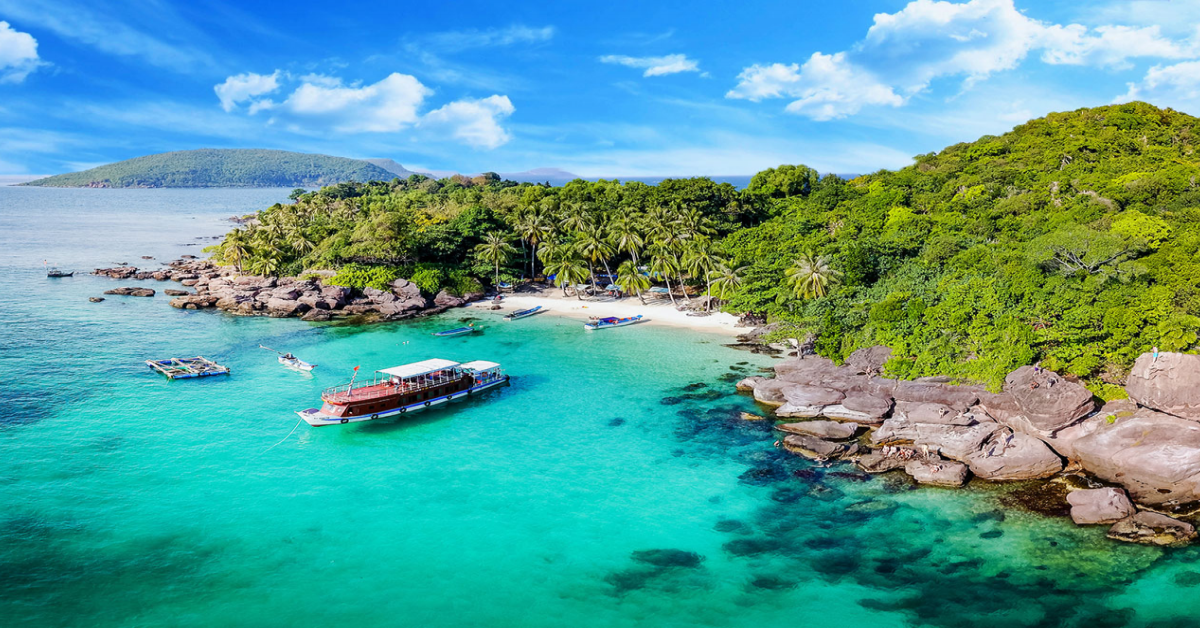Discover the 16 Must-Visit Destinations in Cao Bang, Vietnam
Unveil the stunning landscapes and vibrant culture of Cao Bang through this handpicked list of 16 top-rated attractions. From majestic waterfalls to ancient caves, discover the natural and historical wonders that make this province in Northern Vietnam truly special.
1. Ban Gioc Waterfall (Detian Waterfall)
.png-image-humhqkql.png)
Introduction to Ban Gioc Waterfall
Nestled along the Vietnam-China border in Cao Bang Province, Ban Gioc Waterfall is a spectacular natural treasure drawing visitors from all corners of the globe. It stands as Southeast Asia’s largest natural waterfall and ranks as the world’s fourth largest that crosses an international boundary.
Why Visit Ban Gioc Waterfall?
Boasting a dramatic height of 53 meters and a vast width of 300 meters, Ban Gioc Waterfall flows down in three cascading levels. Surrounded by verdant hills and karst formations, the waterfall paints a mesmerizing scene of misty rainbows and emerald waters—especially vibrant during summer when the flow is at its peak.
The melodic roar of rushing water and the serene ambiance make it an idyllic location for sightseeing, unwinding, and taking postcard-perfect photos.
Highlights at Ban Gioc Waterfall
- Phat Tich Truc Lam Pagoda: Located just 500 meters away, this peaceful temple features traditional Vietnamese architecture and offers panoramic views of the surrounding mountains and the waterfall itself.
- Ban Gioc Waterfall Festival: Held every October, this lively event features cultural performances, folk games, and regional culinary specialties—offering a deep dive into the local way of life.
Visitor Information about Ban Gioc Waterfall
- Entrance Fees of Ban Gioc Waterfall:
- Adults: 45,000 VND
- Children (1 to 1.3 meters): 20,000 VND
- Children under 1 meter: Free
- How to Get Ban Gioc Waterfall:
- By car or motorbike: Approximately 6–7 hours from Hanoi.
- By bus: Travel to Cao Bang City, then continue by taxi or motorbike.
- Via tour packages: Many travel agencies offer organized trips including transportation and guides.
- Best Time to Visit Ban Gioc Waterfall: From May to September during the rainy season, when the waterfall flows at full capacity. However, always check the weather forecast as heavy rain might affect travel routes.
More details about Nguom Ngao Cave and Ban Gioc Waterfall listed in 21 Most Beautiful Waterfalls over the world
2. Nguom Ngao Cave (Tiger Cave)
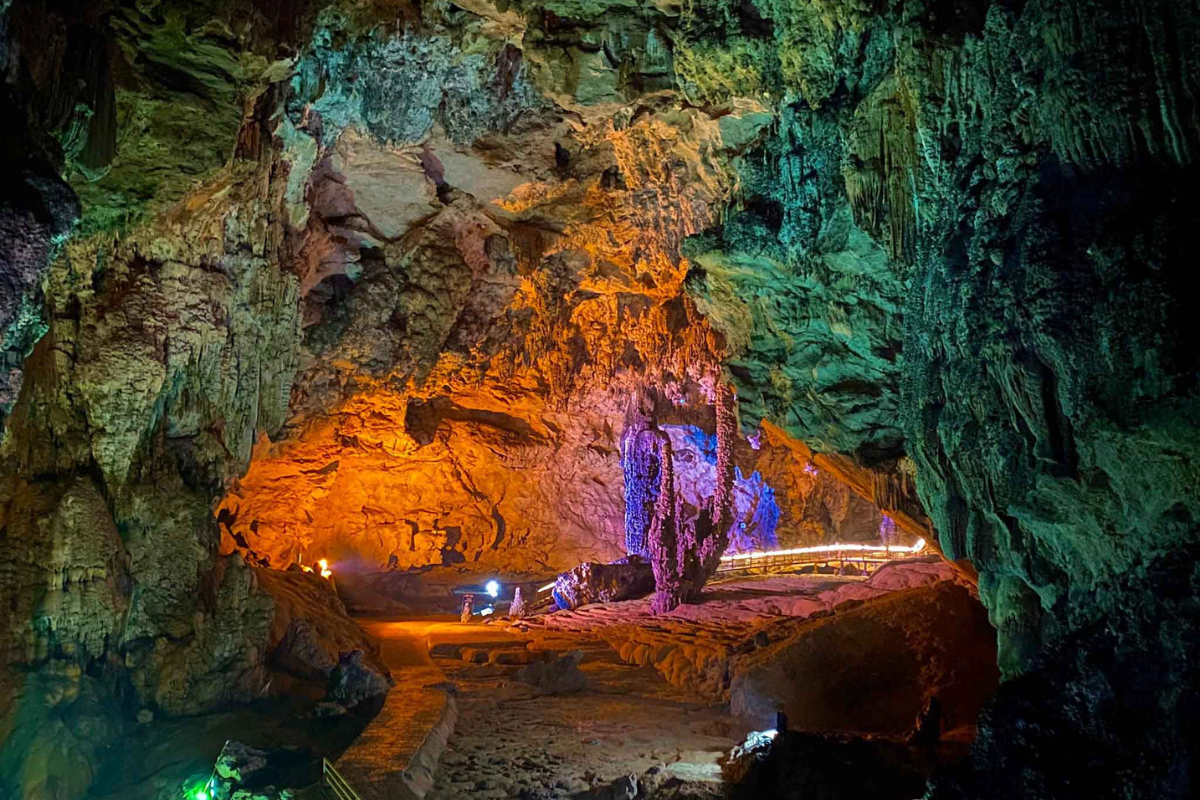
Introduction to Nguom Ngao Cave
Situated near the Vietnam-China frontier in Cao Bang Province, Nguom Ngao Cave—also called Tiger Cave—is an extraordinary geological marvel. Enchanting both nature enthusiasts and thrill-seekers, the cave is steeped in folklore and adorned with ancient formations sculpted by time.
Why Visit Nguom Ngao Cave?
Spanning over 2,100 meters, Nguom Ngao Cave is a journey into an underground world filled with brilliant stalactites and stalagmites in surreal shapes and hues. The interplay of natural light and mineral formations gives the cave a mystical, otherworldly charm that's perfect for exploration and photography.
Highlights of Nguom Ngao Cave
- Geological Formations: Intricate stalactites and stalagmites tell stories shaped over millions of years.
- Underground River: The soft murmur of flowing water enhances the cave’s enchanting atmosphere.
Visitor Information about Nguom Ngao Cave
- Entrance Fees:
- Adults: 30,000 VND
- Children under 1 meter: Free
- How to Get There Nguom Ngao Cave:
- By motorbike: About 2 hours from central Cao Bang, covering roughly 80 km—a scenic and adventurous ride.
- By car with driver: A more relaxed option, especially suitable for families or groups.
- Best Time to Visit Nguom Ngao Cave: Between October and April during the dry season, when the pathways are safer and the formations can be admired at their best.
More details about Nguom Ngao Cave
3. Angel Eye Mountain (Thung Mountain)
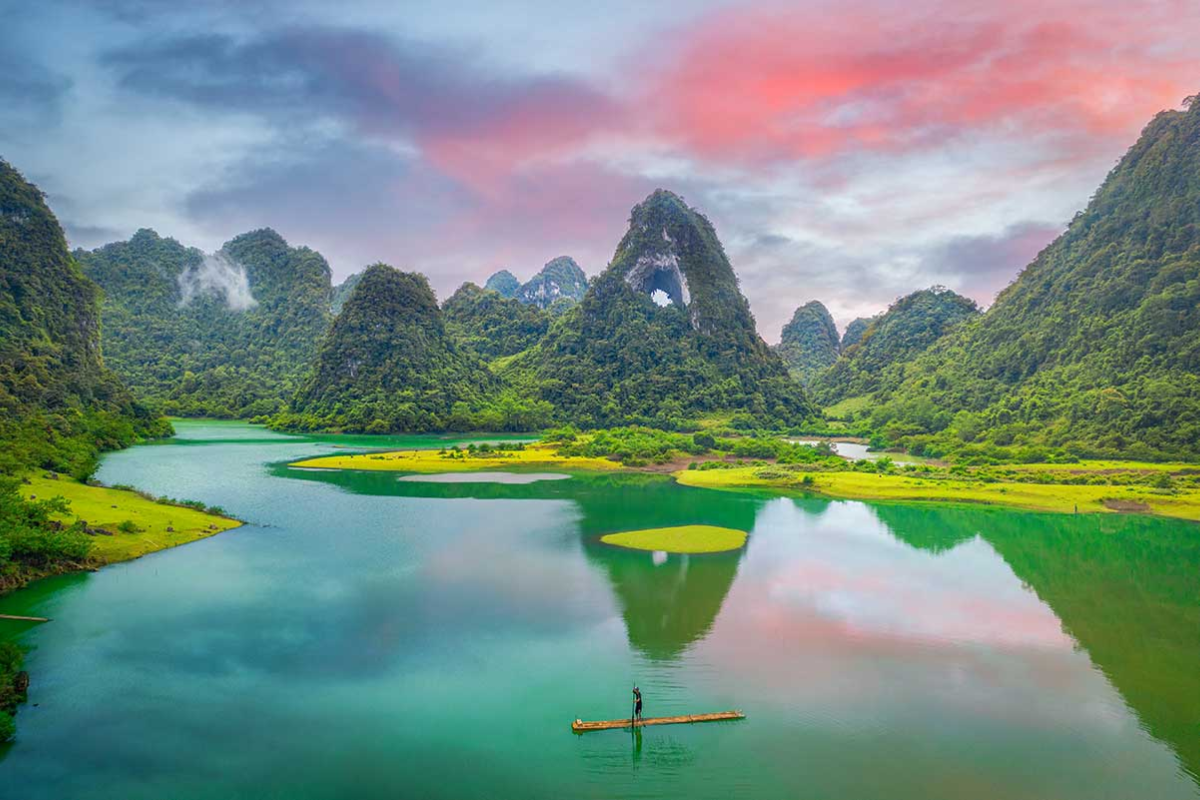
Introduction to Angel Eye Mountain
Located in Cao Bang Province, Angel Eye Mountain (Nui Thung) is a captivating natural marvel that draws travelers with its distinct geological formation and scenic beauty. This remarkable site, named for its eye-shaped cave, offers stunning vistas and various outdoor experiences.
Why Visit Angel Eye Mountain?
Angel Eye Mountain is famed for its large circular hole, around 50 meters wide, that pierces through the mountain, giving it its iconic appearance. Surrounded by lush grasslands and tranquil lakes, it’s an ideal destination for those seeking peace and natural splendor.
During the rainy season, the adjacent Nam Tra Lake becomes a reflective mirror of the surrounding landscape. In contrast, the dry season reveals expansive meadows where local herds graze, creating a vibrant pastoral scene.
Key Attractions at Angel Eye Mountain
- Nam Tra Waterfall
A short walk from the lake leads to Nam Tra Waterfall, a graceful cascade that flows over stone ledges—perfect for relaxing, taking photos, or enjoying a picnic in nature. - Cultural Experience in Ban Danh Village
Visit the nearby Ban Danh Village, where you can meet the Tay ethnic community, admire traditional stilt houses, and immerse yourself in the peaceful rural lifestyle.
Practical Information for Visitors
Entrance Fees:
- Adults: Free
- Children under 1 meter: Free
Getting to Angel Eye Mountain:
The mountain is situated about 30 kilometers from Cao Bang City and is accessible via car or motorbike. For adventure lovers, motorbiking through the winding roads provides a scenic and enjoyable journey.
Best Time to Visit:
The most picturesque time to visit is during the harvest season, from September to October, when golden rice fields stretch across the landscape and the weather is comfortably cool.
More details about Angel Eyes Mountain & Thang Hen Lake
4. Thang Hen Lake
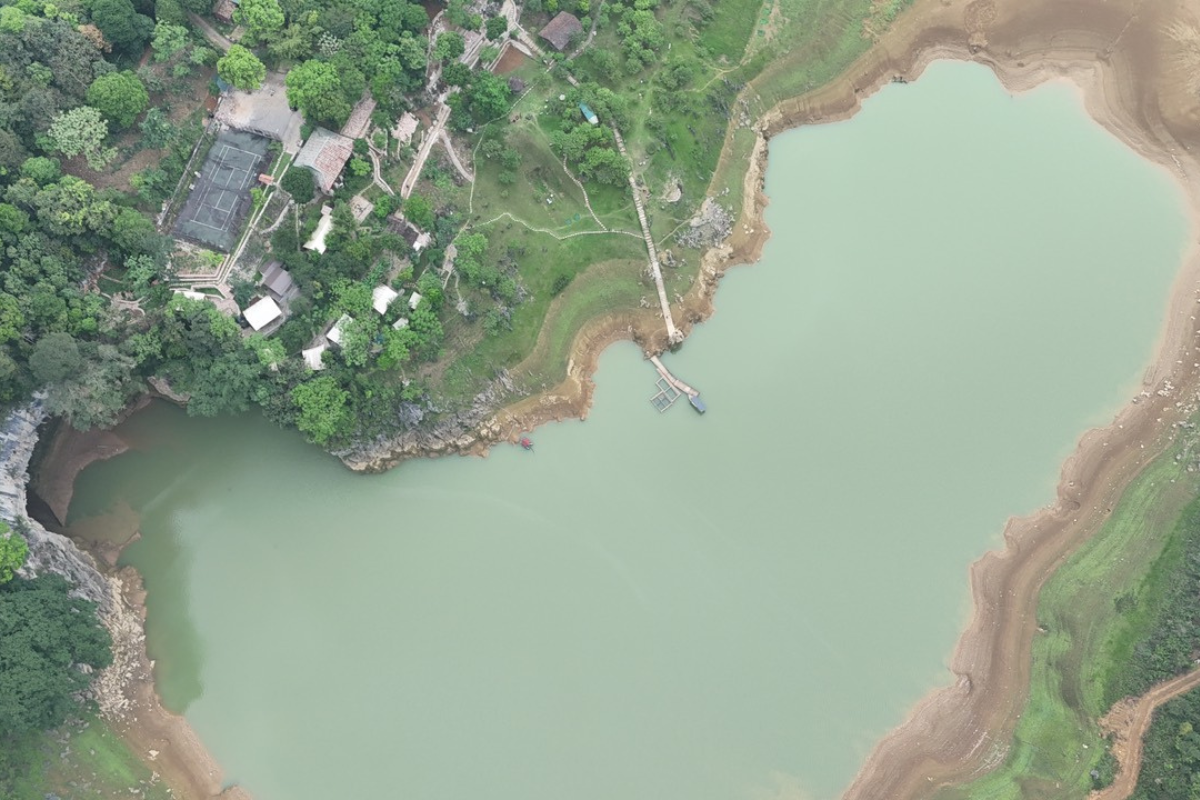
Introduction to Thang Hen Lake
Thang Hen Lake in Cao Bang Province is a spectacular destination nestled in the serene landscapes of Quoc Toan Commune, Tra Linh District. This breathtaking system of 36 interconnected lakes offers an idyllic retreat for nature lovers.
Why Visit Thang Hen Lake?
Famous for its striking diamond-like shape, Thang Hen Lake spans about 300 meters in width and 1,000 meters in length. Its emerald green waters reflect the surrounding limestone mountains, creating a picture-perfect scene. The peaceful environment makes it a great spot for unwinding and capturing memorable photos.
During the rainy season, the lake reaches its most enchanting state, surrounded by lush vegetation and vibrant scenery. In contrast, the dry season unveils hidden cave systems and new walking trails to explore.
Key Attractions at Thang Hen Lake
- Stunning Natural Scenery
With dense forests and majestic cliffs encircling the lake, visitors are treated to a panoramic escape into unspoiled nature. Seasonal color changes add to its ever-changing beauty. - Cultural Encounters
Connect with the Tay and Nung ethnic communities, learning about their time-honored customs, traditional crafts, and regional dishes while visiting nearby villages. - Outdoor Activities
Engage in recreational activities such as kayaking, fishing, and trekking. The lake area also offers perfect spots for picnics and enjoying the tranquil ambiance.
Practical Information for Visitors
Entrance Fees:
- Adults: Free
- Children under 1 meter: Free
Best Time to Visit:
While Thang Hen Lake is scenic year-round, the most ideal period to visit is from September to October, when rainfall fills the lake and the landscape turns lush and colorful. Spring and summer also offer mild temperatures and blooming flora.
How to Get There:
- By Motorbike: Enjoy a picturesque 30-kilometer ride from Cao Bang City with breathtaking scenery along the way.
- By Bus: Take a bus to Cao Bang and then hire a motorbike taxi to reach the lake.
- By Car: Renting a car or joining a local tour group offers the most comfortable and hassle-free option.
More details about Thang Hen Lake
5. Cao Bang Non Nuoc Geopark
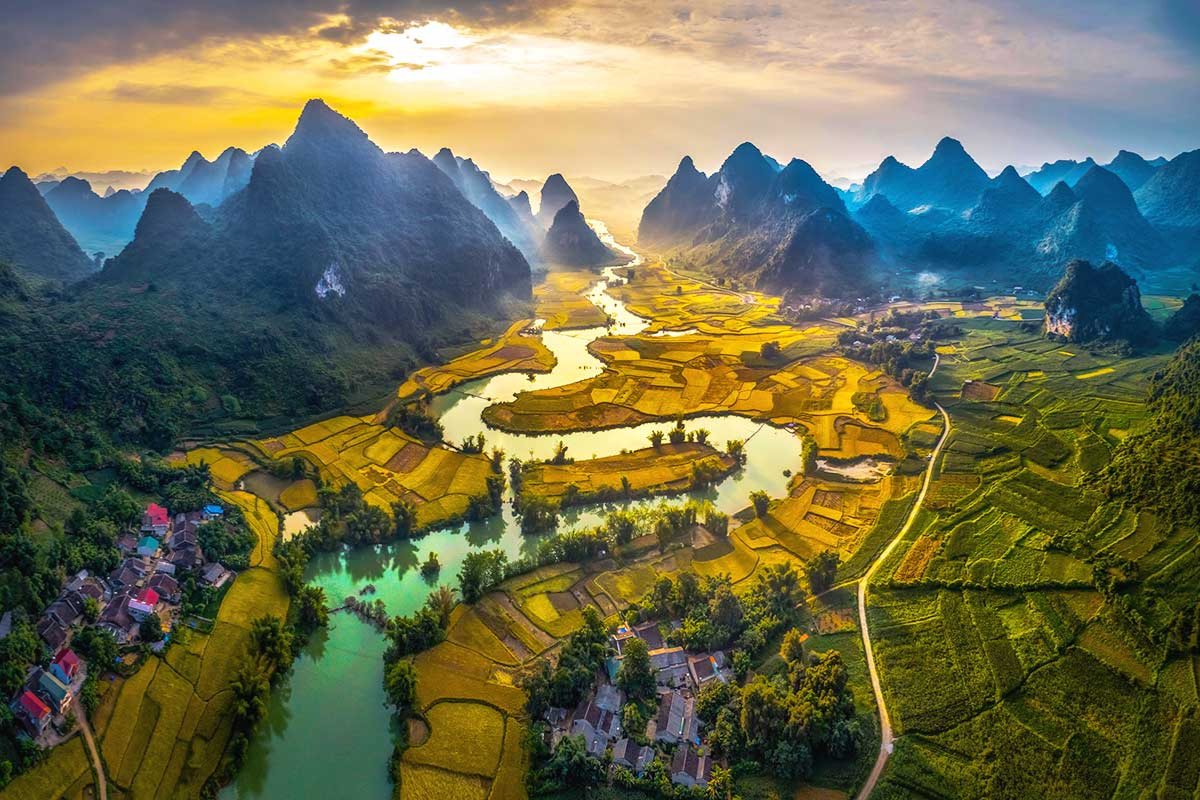
Introduction to Non Nuoc Cao Bang Geopark
Non Nuoc Cao Bang UNESCO Global Geopark is a spectacular natural wonder located in Cao Bang Province, Vietnam. Spanning over 3,275 km², this geopark features breathtaking landscapes and remarkable biodiversity, making it a must-visit for nature enthusiasts.
Why Visit Non Nuoc Cao Bang Geopark?
The geopark showcases a wide array of geological formations, including limestone cliffs, mysterious caves, and verdant valleys. Its unique karst topography creates a mesmerizing backdrop ideal for exploration, photography, and learning about the geological and cultural significance of the area.
Key Attractions in Non Nuoc Cao Bang Geopark
- Ban Gioc Waterfall: One of the most stunning waterfalls globally, Ban Gioc cascades dramatically over limestone ridges, offering a serene and picturesque scene.
- Nguom Ngao Cave: A cavernous marvel filled with intricate stalactites and stalagmites, perfect for adventurers.
- Thang Hen Lake: A beautiful lake complex offering tranquil boat rides and panoramic views, ideal for nature lovers.
- Phia Oac and Phia Den: Ecotourism areas that are ideal for hiking and experiencing Cao Bang’s diverse plant and animal life.
Cultural Heritage
Home to around 250,000 residents from nine ethnic groups, the geopark region is rich in culture and tradition. Visitors can enjoy local festivals, discover artisan crafts, and taste regional dishes, deepening their appreciation for the area's heritage.
Getting to Non Nuoc Cao Bang Geopark
- By Car or Motorbike: Around 6 to 7 hours from Hanoi.
- By Bus: Travel to Cao Bang City, then continue by taxi or motorbike.
- Organized Tours: Many tour operators offer transportation and guided visits to the geopark.
Best Time to Visit Non Nuoc Cao Bang Geopark
The most favorable time to visit is during the dry season from September to April. The rainy season, from May to August, also provides beautiful vistas, especially when waterfalls are at their fullest. Choose your timing based on the experience you’re seeking.
6. Me Pia Pass
.jpg-image-goixfqxt.jpg)
Introduction to Me Pia Pass
Me Pia Pass in Cao Bang Province is one of Vietnam's most thrilling and scenic mountain roads, renowned for its 14 dramatic curves. This iconic route offers an unforgettable journey through breathtaking natural landscapes.
Why Visit Me Pia Pass?
Nicknamed the "14-storey pass," Me Pia is surrounded by verdant hills and towering cliffs. With its hairpin turns and spectacular views, it appeals to both adrenaline seekers and scenic drive enthusiasts.
Key Attractions at Me Pia Pass
- Scenic Views: Panoramic vistas of mountain ranges and lush valleys create a dreamlike atmosphere, perfect for photography.
- Thrilling Rides: Its winding roads are a favorite among experienced motorbike riders looking for an adventurous challenge.
- Cultural Encounters: Interact with local ethnic groups along the way and learn about their unique customs and lifestyle.
Practical Information for Visitors
Getting to Me Pia Pass:
- From Ha Giang: Follow National Road 4C from Meo Vac to Bao Lam, then take National Road 34 to Bao Lac and continue along the Gam River.
- From Hanoi: Travel by bus to Cao Bang, rent a motorbike, and take National Road 34 toward Bao Lac along the Gam River.
Best Time to Visit:
The best months to visit are August and September, when the weather is mild. Alternatively, travel between December and February to admire cherry and apricot blossoms that enhance the pass’s scenic charm.
Conclusion
Me Pia Pass is more than a mountain road—it's an adventure that unveils the raw beauty and cultural richness of Cao Bang. Whether you travel on two wheels or by foot, the experience is guaranteed to be unforgettable.
More details about Me Pia Pass
7. Na Tenh Pass
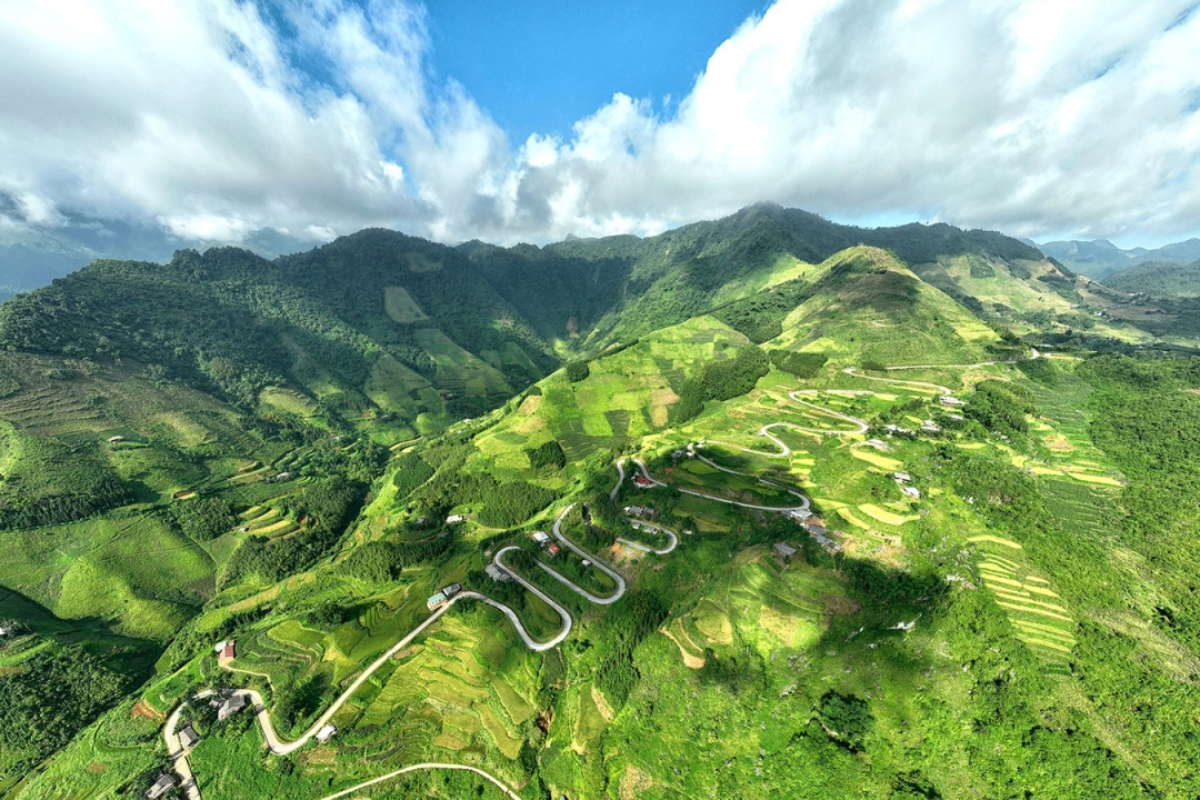 Introduction to Na Tenh Pass
Introduction to Na Tenh Pass
Nestled in the rugged terrain of Cao Bang, Na Tenh Pass is a hidden gem offering tranquility and natural charm. Along with Me Pia and Khau Coc Cha passes, it adds to the captivating appeal of Northern Vietnam’s highlands.
Why Visit Na Tenh Pass?
Though less famous, Na Tenh Pass enchants travelers with its graceful curves and serene ambiance. The pass is relatively easy to traverse, making it suitable for all types of visitors. It passes through a scenic rural landscape dotted with rice fields, corn plantations, and traditional stilt houses.
Key Attractions at Na Tenh Pass
The 2.5-kilometer pass features 20 soft bends that reveal some of the most scenic landscapes in the region. Views include terraced fields, the slopes of Coc Cha Mountain, and peaceful local villages. Along the way, travelers can indulge in local specialties such as roasted duck, smoked pork ribs, ant egg cakes, and black jelly.
Practical Information for Visitors
Despite its ranking among Vietnam's top 10 most dangerous passes, Na Tenh Pass is relatively mild, with fewer sharp turns than others like Ma Pi Leng or O Quy Ho. It is suitable for bicycles, motorbikes, and cars. The route offers a peaceful journey through traditional northern countryside.
Getting to Na Tenh Pass
Na Tenh Pass is located in Can Nong commune, Ha Quang district, and borders Xuan Truong commune in Bao Lac district. Travelers from Ha Giang to Cao Bang will encounter it after passing through Khau Coc Cha Pass. It’s accessible by motorbike, car, or even bicycle, depending on your preferred mode of travel.
Best Time to Visit
September to October is the ideal time to visit when the rice fields turn golden. Alternatively, May to July offers vibrant green cornfields, perfect for enjoying the area's agricultural charm and natural beauty.
More details about Na Tenh Pass
8. Tay Ethnic Minority Village, Cao Bang
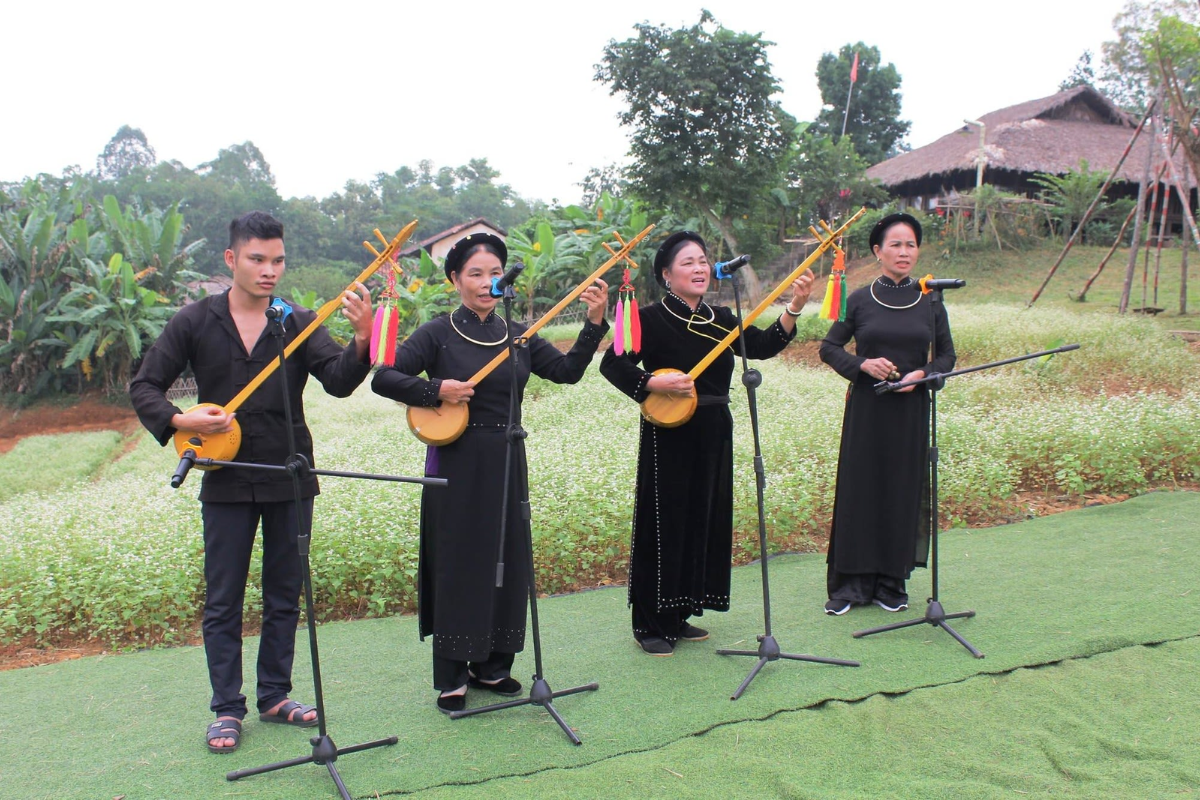
Introduction to Tay Ethnic Minority Village
Nestled in the scenic landscapes of Cao Bằng Province, Tày ethnic minority villages offer a culturally immersive retreat framed by Vietnam’s mountainous north. Often found near rivers or at the base of limestone ridges, these communities are home to the Tay—Vietnam’s second-largest ethnic group—celebrated for their strong traditions and harmonious relationship with the environment.
Why Visit a Tay Ethnic Minority Village?
Exploring a Tay village allows travelers to slow down and experience centuries-old traditions in a tranquil rural setting. Characterized by stilt houses, handwoven crafts, and melodic folk performances, these villages preserve a vibrant cultural tapestry. The villagers' warm hospitality and the region’s serene scenery provide an enriching travel experience.
Key Attractions in a Tay Village
- Traditional Stilt Houses: Signature stilt homes constructed from bamboo and wood, featuring thatched palm roofs, are built to suit the mountainous terrain. These elevated homes provide natural ventilation during warmer months, and strolling past them offers insight into Tay lifestyle.
- Cultural Activities: Visitors can watch locals weaving brocade, cooking over open fires, or performing folk songs accompanied by the two-stringed đàn tính lute. Traditional ceremonies often feature music, storytelling, and spiritual rituals.
- Natural Beauty: Surrounded by lush rice paddies, bamboo clusters, and meandering streams, Tay villages are ideal for photography, leisurely walks, and a deep connection with nature.
Practical Information for Visitors
Entrance Fees:
• Adults: Free
• Children under 1 meter: Free
Best Time to Visit
September to November is ideal, when the weather is cool and rice terraces glow golden at harvest. Spring (March to May) also brings pleasant temperatures and colorful festivals.
How to Get There
- Motorbike: Scenic routes from Cao Bằng City offer a rewarding ride through mountain and field vistas.
- Bus: Reach Cao Bằng by bus and hire a motorbike taxi or guide to the village.
- Car: Renting a car or booking a tour provides comfort and flexibility, especially when combining visits with nearby attractions like Thang Hen Lake or Na Tenh Pass.
9. Phia Thap Incense Sticks Village, Cao Bang
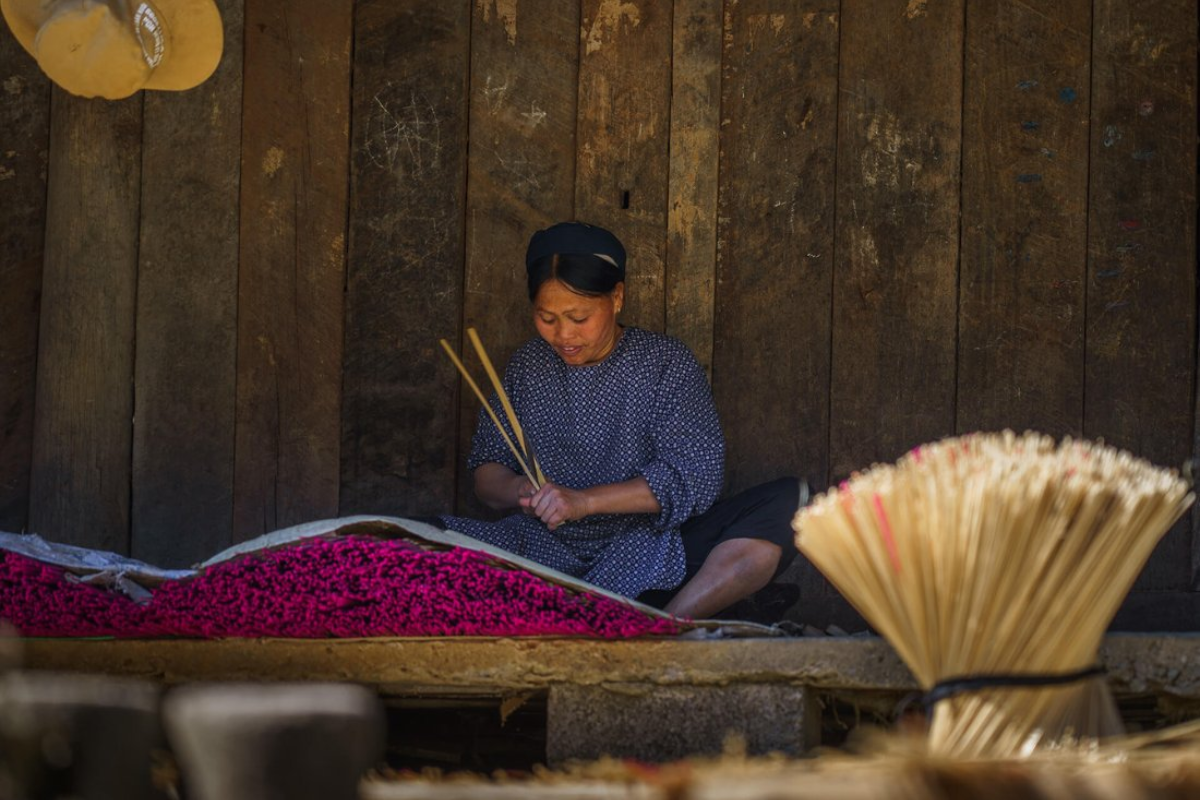
Introduction to Phia Thap Incense Sticks Village
Situated in Phuc Sen commune, Quang Hoa district, Phia Thap Village is among seven officially recognized traditional craft villages in Cao Bang. Known for its enduring incense-making heritage, the Nung An ethnic group has carefully preserved this age-old practice.
Why Visit Phia Thap Incense Sticks Village?
Phia Thap offers a window into Northern Vietnam’s artisanal heritage. Set amidst dramatic mountain backdrops and featuring yin-yang roofed stilt houses, the village allows visitors to observe incense production done entirely by hand—a craft passed down through generations.
Key Attractions at Phia Thap Incense Sticks Village
- Traditional Incense Making: Made from natural, chemical-free ingredients, the incense uses powdered Bầu Hắt tree leaves and flexible bamboo called "cây mạy mười" sourced locally.
- Manual Craftsmanship: Over 50 households still follow traditional techniques, from splitting bamboo to sun-drying sticks—all carried out by hand, reflecting deep pride and skill.
- Cultural Encounters: Stroll through the village to interact with locals, observe daily life, and gain insight into Nung An customs and values.
- Homestay Options: Overnight stays in stilt homes offer hands-on incense-making workshops, home-cooked meals, and a tranquil glimpse into rural life.
Practical Information for Visitors
Phia Thap incense is a cherished household item in Cao Bang and neighboring regions like Bac Kan and Lang Son. Many homes dedicate an entire floor to incense crafting. Visitors are encouraged to respect local customs during their visit.
Getting to Phia Thap Incense Sticks Village
- Car or Motorbike: Located 25 km from Cao Bằng City and 325 km from Hanoi, the village is an ideal stop en route to Ban Gioc Waterfall.
- Guided Tours: For a comprehensive cultural journey, join a tour combining Phia Thap with destinations like Ba Be Lake and Ban Gioc waterfall. Tours typically include guides, transportation, and insights into local life.
Best Time to Visit Phia Thap Incense Sticks Village
Visit during the dry months from October to April for ideal weather and clear skies—perfect for photographing sun-dried incense and engaging with villagers outdoors.
More details about Phia Thap Incense Sticks Village
10. Khuoi Ky Stone Village
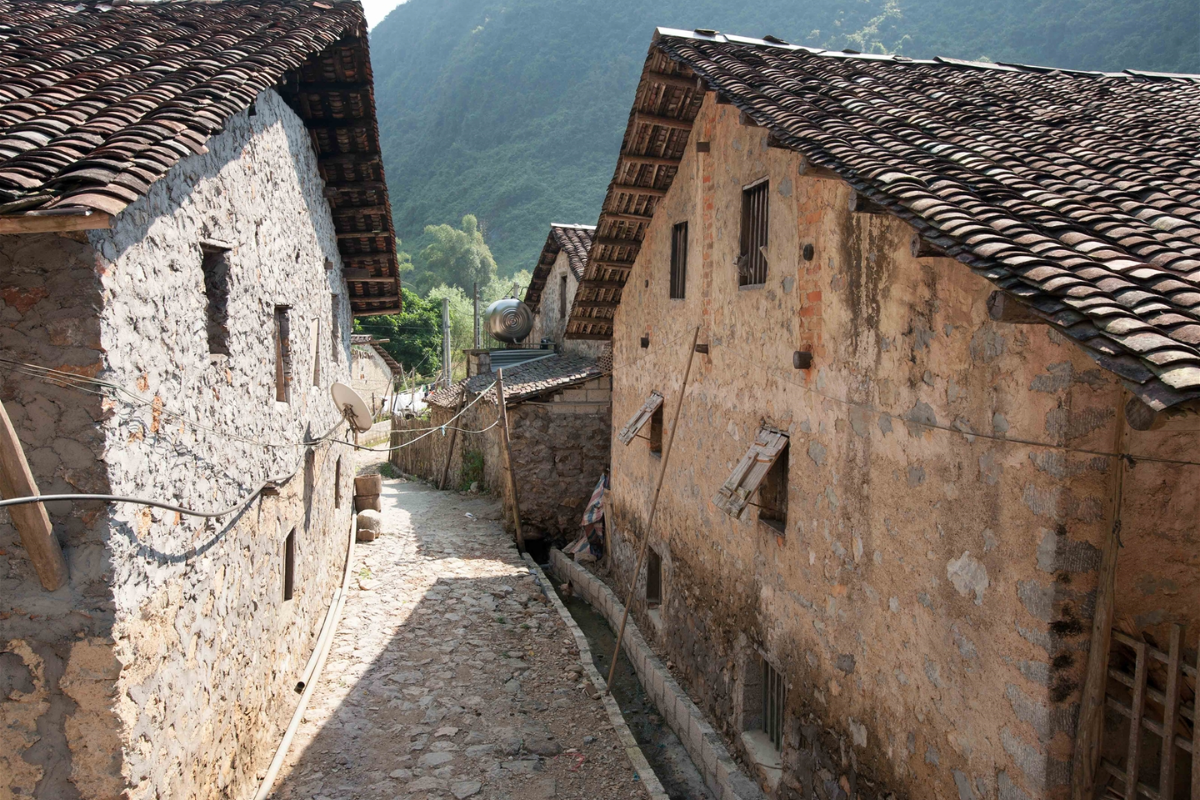
Introduction to Khuoi Ky Stone Village
Located near the Vietnam-China border in Cao Bằng, Khuoi Ky Stone Village (Khuổi Ky) is a remarkable example of Tay heritage and stone craftsmanship. "Khuoi Ky" means "small stream" in Tay, named after the waterway running past the village, flanked by majestic stone peaks. Spanning around 10,000 square meters, this village features 14 stone stilt houses and remains a spiritual and cultural cornerstone for the Tay people.
Why Visit Khuoi Ky Stone Village?
Khuoi Ky presents a fusion of natural beauty, historic architecture, and cultural legacy. With its rare stone homes and serene atmosphere, the village is a compelling stop for travelers exploring nearby attractions like Ban Gioc Waterfall and Nguom Ngao Cave.
Key Attractions at Khuoi Ky Stone Village
- Stone Stilt Houses: Built with flagstone bases and carved stone columns, these homes showcase a unique construction style passed down for nearly 400 years. Interiors feature wooden frames and three functional sections reflecting traditional Tay architecture.
- Living Tay Culture: Visitors can witness rituals, examine ancestral relics, and learn about the stone god—believed to be central to the Tay
More details about Khuoi Ky Stone Village
11. Phuc Sen Blacksmith Village
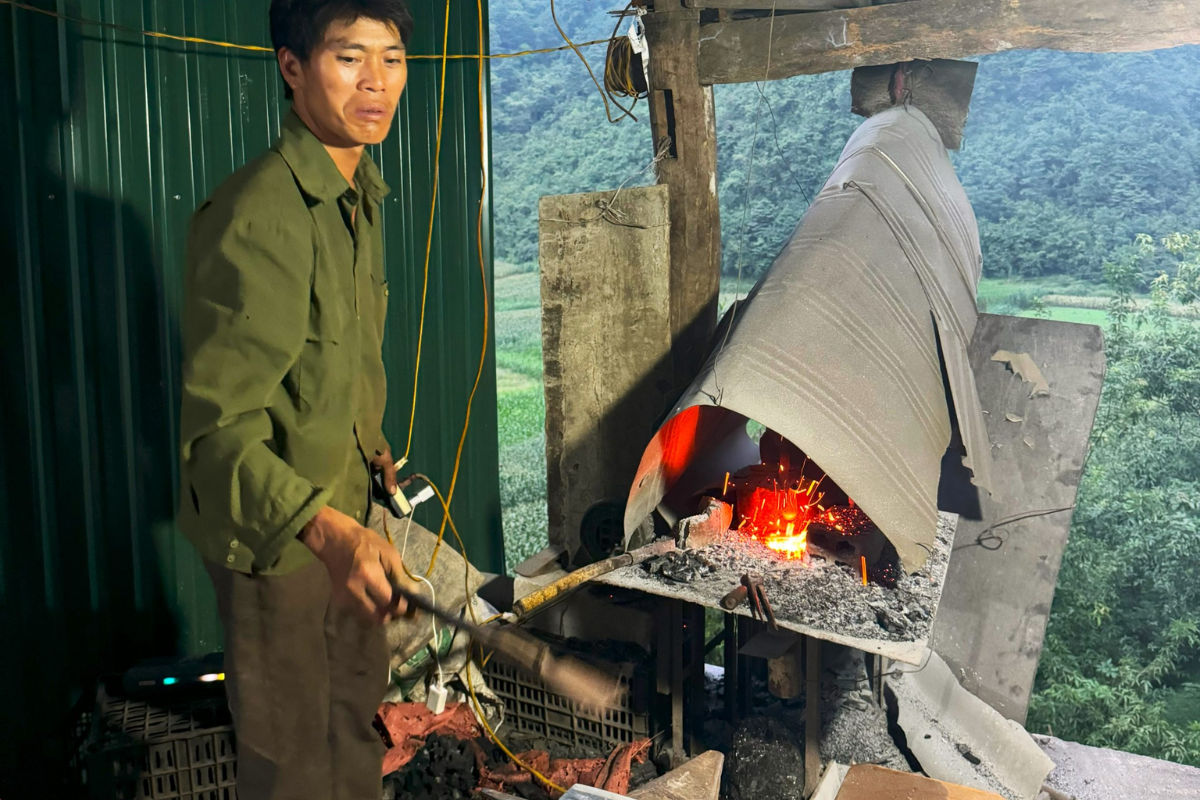
Introduction to Phuc Sen Blacksmith Village
Phuc Sen Forging Village in Cao Bang Province stands as a testament to Vietnam’s centuries-old blacksmithing legacy. For over 1,000 years, the Nung ethnic minority has upheld traditional forging techniques, crafting durable and intricately made tools. This village remains one of the few authentic craft communities where age-old hand-forging traditions thrive despite modern advancements.
Why Visit Phuc Sen Blacksmith Village?
Phuc Sen offers a rare opportunity to explore a living artisanal tradition centered on blacksmithing, a craft deeply woven into the Nung ethnic identity. Tourists can witness the intricate forging processes up close, gain insights into ancestral methods, and experience rural Vietnamese life untouched by industrialization. Visitors often take home hand-forged tools, admired for their craftsmanship and longevity.
Key Attractions at Phuc Sen Blacksmith Village
- Live Blacksmith Workshops: Observe artisans crafting knives, sickles, and agricultural tools using time-honored techniques such as water quenching. Some workshops allow hands-on participation.
- Nung Ethnic Culture: Discover stilt houses, traditional weaving, local dishes like “khau nhuc” and five-color sticky rice, and seasonal festivals featuring folk music and dance.
- Historical Insight: Engage with blacksmiths as they share the village’s 1,000-year-old legacy and personal family stories of craftsmanship.
- Shopping for Handmade Tools: Buy authentic tools made from recycled steel and fitted with handles made from native Cam Chi wood.
- Sustainable Craftsmanship: Learn about eco-conscious forging practices that support both the environment and the local economy.
Practical Information for Visitors
- Opening Hours: Daily from 6:30 AM to 6:30 PM.
- What to Expect: Expect to see glowing forges, the rhythmic clanging of hammers, and dimly lit workshops bustling with activity.
- Participation: Some blacksmiths invite visitors to try forging under supervision.
- Local Cuisine: Sample authentic Nung dishes at local eateries.
- Accommodation: Limited lodging in the village—day trips from Cao Bang City are common.
- Purchasing: Choose from kitchen knives, machetes, sickles, and engraved blades—each handmade and authentic.
Getting to Phuc Sen Blacksmith Village
- From Hanoi to Cao Bang (approx. 280 km):
- Bus: 6–8 hours, 200,000–350,000 VND from My Dinh or Gia Lam stations.
- Limousine: 5.5–7 hours, 400,000–600,000 VND—faster and more comfortable.
- Private Car: 5–6 hours, with flexible stops, costing around 3,000,000–4,500,000 VND.
- Motorbike: 8–10 hours for those seeking adventure.
- From Cao Bang to Phuc Sen (approx. 4 km from Quang Uyen District):
- Local Bus: 45–60 minutes, 30,000–100,000 VND.
- Taxi: 30–45 minutes, 200,000–400,000 VND.
Best Time to Visit Phuc Sen Blacksmith Village
- Dry Season (October to April): Comfortable temperatures and better road conditions.
- Spring (February to April): Mild weather (15–25°C), blooming landscapes, and local festivals celebrating ancestral traditions.
- Autumn/Winter (October to January): Pleasant weather (18–28°C), low humidity, and bustling forging activity.
Spring and autumn provide the best cultural and climatic conditions for your visit.
More details about Phuc Sen Blacksmith Village
12. King Le's Temple
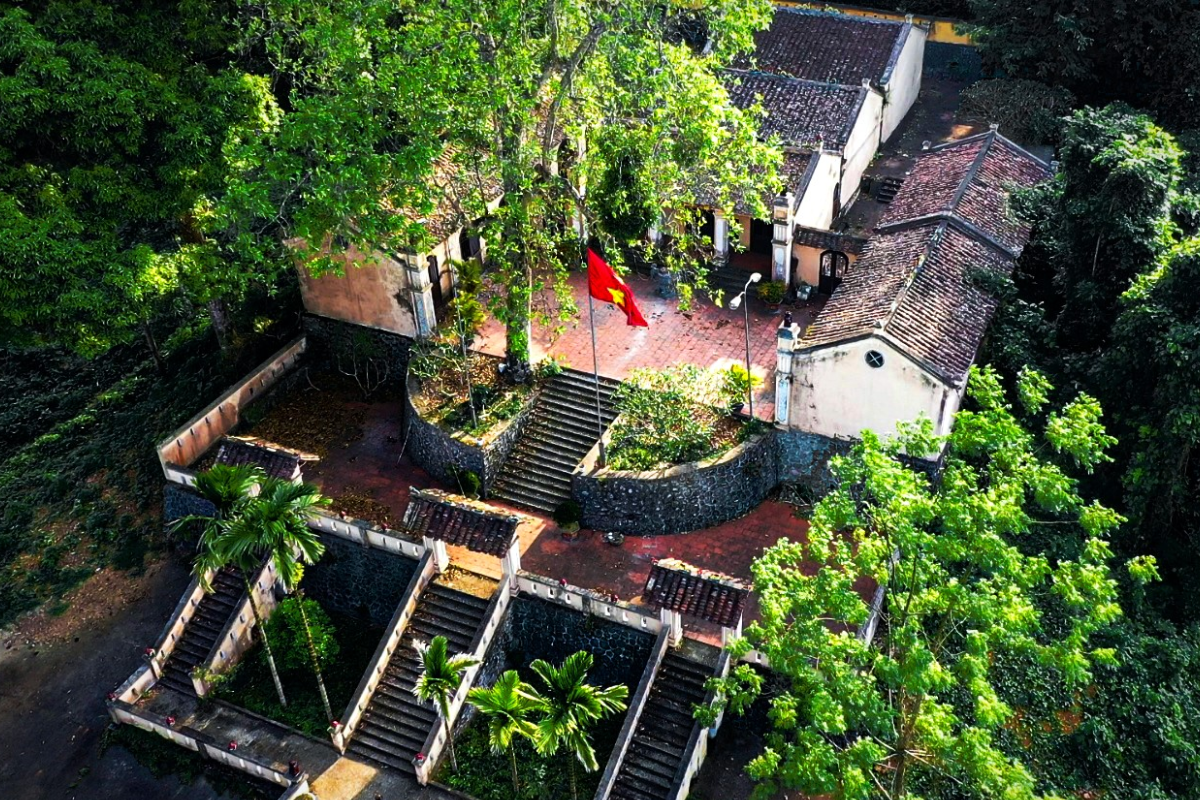
Introduction to King Le's Temple
Located in Den Village, Hoang Tung Commune, Hoa An District—just 11 kilometers from Cao Bang City—King Le's Temple is a revered historical and spiritual landmark. The temple commemorates King Le Thai To, also known as Emperor Le Loi, a heroic figure in Vietnam’s history who led the resistance against the Ming invaders. Perched on Long Mound, a section of the ancient Na Lu Citadel, the site encapsulates centuries of national heritage.
Why Visit King Le's Temple?
King Le's Temple is not merely a religious monument—it represents Vietnamese patriotism, resistance, and identity. This historically significant site is a draw for cultural travelers, history buffs, and spiritual seekers. Its annual festival is a vibrant showcase of local traditions and community pride.
Key Attractions at King Le's Temple
- Historic Architecture: The temple features a traditional triangle layout with three houses and seven compartments, built from bricks, wooden trusses, and tiled roofs.
- Ancient Na Lu Citadel: Constructed by figures like Cao Bien and Nung Ton Phuc in the 11th century, then restored in the 15th century by Be Khac Thieu.
- Cultural Festival: Held on the 6th day of the first lunar month, it includes rituals, folk games (such as human chess and tug of war), and cultural performances.
- Historical Significance: The site played a role in revolutionary activities, including the founding of the "Anti-Imperial Youth Union" in 1936.
- Educational Heritage: Designated a National Historical and Cultural Relic in 1995, offering deep insight into Vietnam's resistance history and cultural continuity.
Practical Information for Visitors
- Location: Den Village, Hoang Tung Commune, Hoa An District, Cao Bang Province—11 km from Cao Bang City.
- Facilities: The temple is enclosed by a 600-meter wall and includes two courtyards covering nearly 1,000 square meters, commonly used for festivals.
- Events: The best time to experience local culture is during the temple festival in the first lunar month.
- Etiquette: Visitors should wear modest clothing and behave respectfully within the temple grounds.
Getting to King Le's Temple
The temple is easily accessible from Cao Bang City by car, motorbike, or taxi. The short 11-kilometer distance makes for a convenient half-day excursion. For travelers from Hanoi, buses and private cars provide access to Cao Bang, from where the temple is just a short ride away.
Best Time to Visit
The ideal time to visit is during the dry season (October to April), when the climate is cool and pleasant. For a truly immersive experience, plan your trip around the King Le Temple Festival in the first lunar month to enjoy traditional games, ceremonies, and cultural activities.
13. Nguom Boc Cave
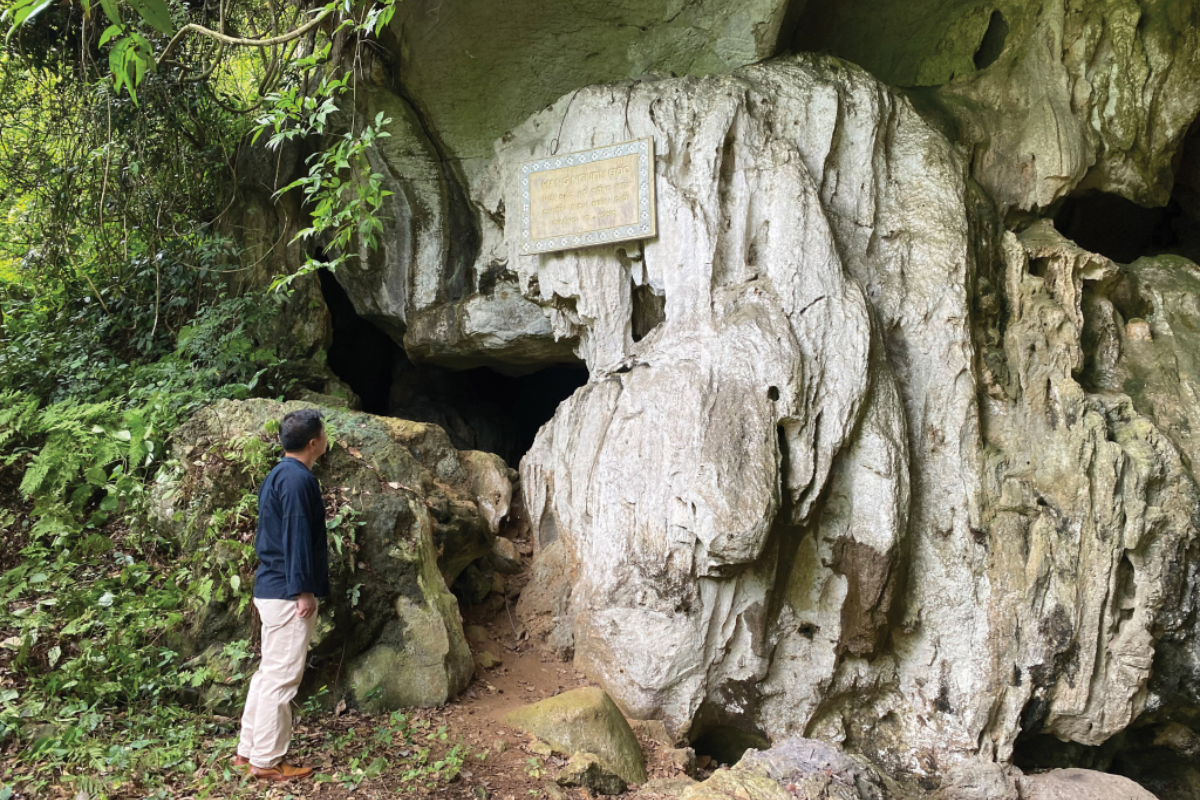
Introduction to Nguom Boc Cave
Nestled on the western slope of the Lam Son mountain range in Ban Nua hamlet, Lam Son village, Hong Viet commune, Nguom Boc Cave—also known as the Dry Cave—is both a geological wonder and a historic treasure in northern Vietnam. Its captivating natural beauty is only matched by its profound significance in Vietnam’s revolutionary history and ancient culture.
Why Visit Nguom Boc Cave?
Nguom Boc Cave offers visitors a rare blend of natural splendor, cultural heritage, and historical depth. This site is not only geologically fascinating but also deeply intertwined with Vietnam’s fight for independence. It is a place where you can walk in the footsteps of President Ho Chi Minh and explore relics from both ancient times and modern revolutions, making it a meaningful destination for history buffs, nature lovers, and cultural enthusiasts alike.
Key Attractions at Nguom Boc Cave
- Historical Significance: The cave served as a critical revolutionary base between 1942 and 1945, where President Ho Chi Minh organized secret meetings and was affectionately known as “Ong Ke” by local Nung people. It also hosted key military planning sessions in May 1945 ahead of the historic August Revolution.
- Revolutionary Relics: In October 1950, the cave was the site of a major conference where President Ho Chi Minh reviewed the Border Campaign and addressed factory workers and local representatives.
- Prehistoric Legacy: Archaeological discoveries at the site point to early Neolithic settlement, connecting the cave to the Hoa Binh Culture from around 10,000 years ago.
- Legendary Origins: In Tay folklore, Nguom Boc is believed to be the first settlement of the legendary figures Pu Luong and Slao Cai in Cao Bang.
- Geological Marvel: Formed in limestone during the Carboniferous-Permian periods (approximately 360–270 million years ago), the cave features remnants of ancient water flows and uplifted terraces, revealing clues about Vietnam’s geological past.
Practical Information for Visitors
Visitors can explore the cave’s interior, which retains natural rock formations and historic areas used during wartime. Guided tours may provide insight into both the natural and historical context of the site. Comfortable walking shoes and a flashlight are recommended for exploring.
Getting to Nguom Boc Cave
Nguom Boc Cave is located in Lam Son village, Hoa An district, Cao Bang province. From the city of Cao Bang, visitors can travel by car or motorbike to Lam Son commune, followed by a short hike to the cave’s entrance in Ban Nua hamlet. Local guides may be available to enhance the experience with historical storytelling.
Best Time to Visit
The best time to visit Nguom Boc Cave is during the dry season, from October to April, when weather conditions are favorable for outdoor exploration. During these months, the terrain around the cave is more accessible, and the surrounding landscape is especially picturesque.
14. Pac Bo Historical Relics Complex
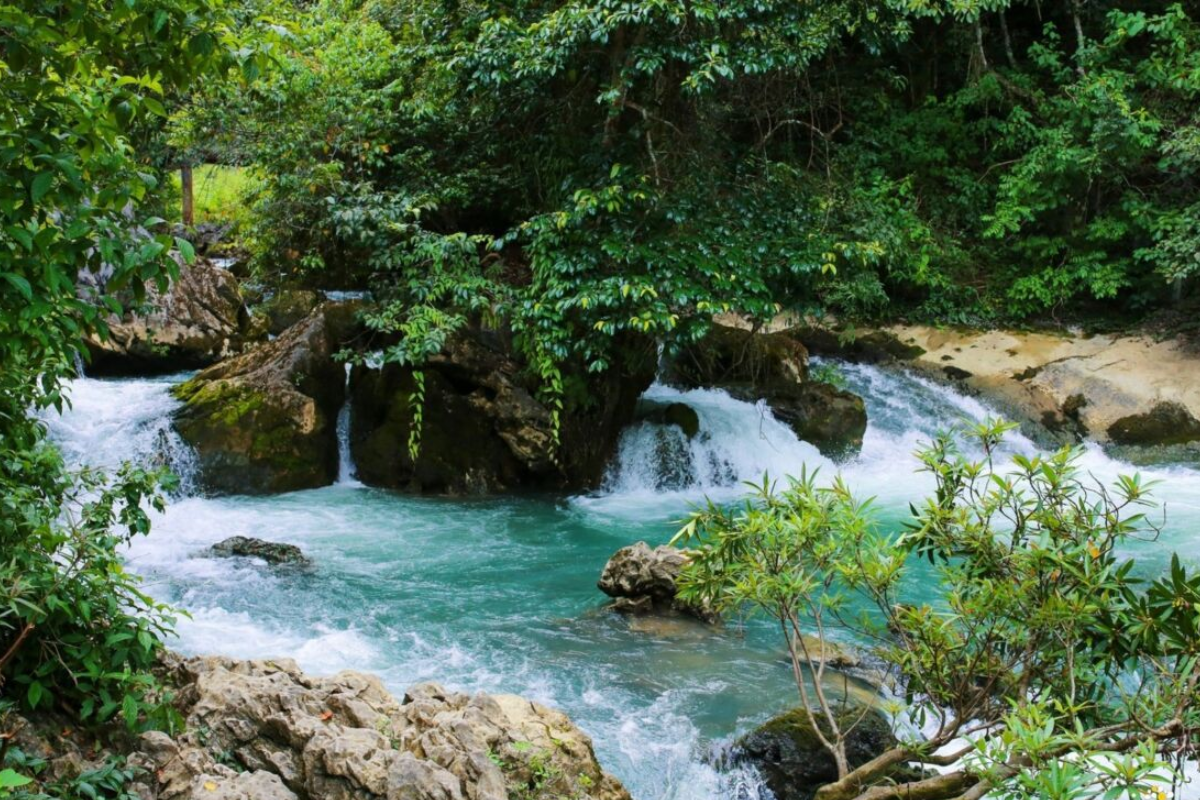
Introduction to Pac Bo Historical Relics Complex
Pac Bo Historical Relics Complex is a significant revolutionary site located in Pac Bo village, Truong Ha commune, Ha Quang district, Cao Bang province. This location marks the return of President Ho Chi Minh to Vietnam in 1941, after 30 years abroad searching for a path to national liberation. It was here that he began laying the groundwork for the resistance against French colonial rule. The site remains a powerful symbol of patriotism, independence, and the early days of Vietnam’s revolution.
Why Visit?
Visiting Pac Bo is an opportunity to explore an essential chapter of Vietnam’s revolutionary history. The site showcases not only historical landmarks tied to President Ho Chi Minh but also a deep connection to the natural surroundings that inspired him. Names like Karl Marx Mountain and Lenin Stream, chosen by the President himself, reflect both ideological values and a love for nature. The site is ideal for those interested in Vietnam’s independence movement, as well as those who appreciate tranquil, mountainous landscapes steeped in historical meaning.
Key Attractions at Pac Bo Historical Complex
- Coc Bo Cave: Also known as Pac Bo Cave, this small cave was where President Ho Chi Minh lived and worked upon returning to Vietnam in early 1941. Inside, visitors can see a stone inscribed with the date February 8, 1941—the day he moved in—as well as his modest sleeping and working area, which reflect his simplicity and determination.
- Karl Marx Mountain: Named by President Ho Chi Minh after the German philosopher, this mountain offers excellent hiking opportunities and sweeping views of the region.
- Lenin Stream: A favorite retreat for the President, this peaceful stream was a place where he would fish and relax after long days of revolutionary work.
- Khuoi Nam Hut: This hut served as President Ho Chi Minh’s primary residence during his time in Pac Bo. Hidden beneath a mountain crevice and surrounded by trees, it provided a discreet location for revolutionary planning. Initially, there was just one hut for the President, but later two more were built for accompanying guards.
- Border Stake 108: This stone marker once marked the boundary between Vietnam and China. Engraved in both Chinese and French, it gained special importance as the site where Ho Chi Minh re-entered Vietnam in 1941. It also stands as a symbol of national sovereignty, especially during the 1979 border conflict, when locals protected it at great personal risk.
- Kim Dong Monument: This monument honors Kim Dong, a young revolutionary who was killed during the anti-French struggle. It serves as a tribute to the courage and sacrifice of Vietnamese youth during the resistance era.
Practical Information for Visitors
The site is well-maintained and suitable for both educational and historical visits. Most of the attractions are accessible on foot, and signs in Vietnamese provide context at each location. Guided tours may be available through local services, and visitors should wear comfortable shoes and be prepared for some walking through hilly terrain.
Getting to Pac Bo
Pac Bo is situated about 55 kilometers from Cao Bang city. From there, it can be reached by taxi, motorbike, or local bus. The route offers scenic views of the northern Vietnamese countryside, making the journey a pleasant part of the experience.
Best Time to Visit
The ideal time to visit Pac Bo is during the dry season, from October to May. During these months, the weather is mild and the landscape is at its most beautiful, with the Lenin Stream flowing gently and the natural surroundings offering a serene, peaceful atmosphere. This period is perfect for those seeking a quiet, reflective visit to a meaningful historical site.
More details about Pac Bo Historical Relics Complex
15. Tran Hung Dao Forest

Introduction to Tran Hung Dao Forest
Nestled in the lush landscapes of Cao Bang Province, Tran Hung Dao Forest stands as a symbol of Vietnam’s revolutionary history. This forest is notably linked to the formation of the Vietnam Liberation Army Propaganda Team—the forerunner of the Vietnam People's Army—and to the legacy of General Vo Nguyen Giap, a key figure in the country’s struggle for independence. Recognizing its profound historical value, the Vietnamese government designated Tran Hung Dao Forest a Special National Monument in 2013. A visit to this site offers a meaningful journey into Vietnam's heroic past.
Why Visit Tran Hung Dao Forest?
Tran Hung Dao Forest is not only a place of great historical significance but also a haven of natural beauty. The area combines tranquil forest landscapes with relics that tell the story of Vietnam’s revolutionary spirit. Visitors have the opportunity to immerse themselves in wartime stories, admire heritage trees, and explore significant battle sites that laid the foundation for Vietnam’s armed resistance. It's an ideal destination for history enthusiasts, nature lovers, and those seeking a deeper understanding of Vietnam’s cultural heritage.
Key Attractions at Tran Hung Dao Forest
- Tran Hung Dao Forest Relic Cluster: This extensive relic area covers more than 201.7 hectares, featuring ancient trees, fresh air, and serene natural surroundings. A highlight is the stele house commemorating the 34 soldiers of the Vietnam Liberation Army Propaganda Team. Nearby, a natural spring still flows with clear water, once used by soldiers. A 300-year-old dragonplum tree, recognized as a Vietnamese Heritage Tree, also stands within the forest.
- Tham Khau Cave: This cave was a crucial revolutionary base from 1941 to 1944. Inside, a stone slab served as a map table for strategic planning, including attacks on Fort Phai Khat and Fort Na Ngan. Its location was ideal—secluded yet suitable for observation and communication. The cave was also a key supply and contact station for revolutionary forces.
- Fort Phai Khat: The site of the Vietnam Liberation Army Propaganda Team's first victory on December 25, 1944, Fort Phai Khat holds a revered place in Vietnamese military history. This battle marked the beginning of the Vietnamese People's Army’s tradition of triumph, earning it recognition as a National Relic in 1993.
- Fort Na Ngan: This hilltop fort was the scene of the second victorious engagement by the liberation army on December 26, 1944. Though difficult to access, the fort’s strategic importance is undeniable. Ongoing preservation efforts underscore its historical significance and educational value for future generations.
- Va Pha Relic: Located in Ban Um Hamlet at the foot of Slam Khau Hill, Va Pha is where a crucial military training camp was established in February 1944. Led by General Vo Nguyen Giap and Le Thiet Hung, this training prepared cadres from across the province, laying the groundwork for the Vietnam Liberation Army Propaganda Team. Remnants of the training site, including camp stone arrangements, still remain.
Practical Information about Tran Hung Dao Forest for Visitors
Tran Hung Dao Forest is situated in Tam Kim and Hoa Tham Communes, Nguyen Binh District, Cao Bang Province. The relics are spread across rugged but scenic terrain, offering opportunities for walking and historical exploration. Visitors should prepare for basic trekking and bring comfortable footwear, water, and insect repellent. Local guides can enhance the experience with detailed historical narratives.
Getting to Tran Hung Dao Forest
From Hanoi, the journey to Cao Bang spans approximately 280 kilometers, taking about 4.5 to 6 hours depending on the route. The most common path begins via Nhat Tan Bridge, continuing on National Highway 3 through Thai Nguyen and Bac Kan to reach Cao Bang City. From there, an additional 52-kilometer drive—around 1.5 hours—is required to get to Nguyen Binh District, where Tran Hung Dao Forest is located.
Best Time to Visit Tran Hung Dao Forest
The best time to visit Tran Hung Dao Forest is during the dry season from October to April, when the weather is cooler and more suitable for hiking and sightseeing. During this period, the forest is lush, and the historical sites are easily accessible. Avoid the rainy season (May to September), as trails can become slippery and travel may be less convenient.
16. Kolia Tea Plantation
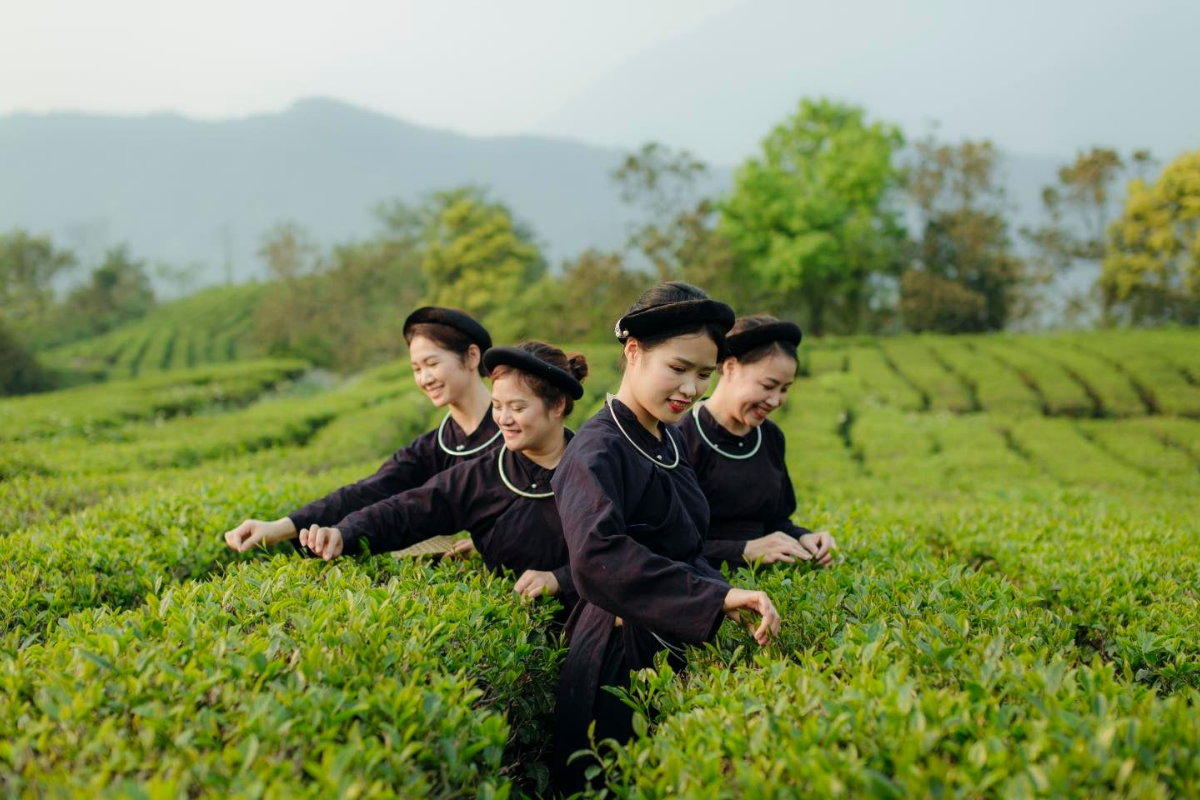
Introduction to Kolia Tea Plantation
Nestled in Phia Den, located in Thanh Cong commune of Nguyen Binh district, the Kolia Tea Plantation lies at an impressive altitude of 1,300 meters above sea level. This highland destination, often referred to as "heaven on Earth," is known for its pristine natural beauty, featuring towering mountains, dense forests, and skies adorned with floating white clouds. Leveraging these natural advantages, Kolia Co., Ltd. has established a unique presence in the region.
Why Visit Kolia Tea Plantation?
Travelers seeking a blend of nature, culture, and sustainable tourism will find Kolia Tea Plantation an ideal destination. The area offers a peaceful retreat where guests can immerse themselves in breathtaking landscapes, savor organic highland tea, and learn about the efforts to promote environmentally responsible agriculture and local employment.
Key Attractions at Kolia Tea Plantation
- Sightseeing Dome: Perched high above the tea hills, this dome offers panoramic views of the surrounding mountains and plantations.
- Flower Gardens: Vibrant seasonal blooms make for a colorful and fragrant visit.
- Rest Houses & Cafeteria: Comfortable accommodations and a cozy spot to enjoy Phia Den’s signature teas.
- Singing Room: A place to relax and enjoy music in the middle of the tranquil highlands.
- Physio-therapy Treatment: Wellness services for those looking to rejuvenate amid nature.
A cup of Phia Den tea sipped in this serene setting, with fresh air and romantic vistas, makes for an unforgettable experience.
Practical Information for Visitors
- Organic Tea Production: Kolia’s tea is cultivated following international organic standards, using a rigorous, clean production model from planting to packaging.
- Eco-Friendly Mission: The plantation prioritizes sustainability, environmental protection, and creating jobs for the local community.
- Product Reach: Phia Den tea has gained recognition in both domestic and international markets, especially in Taiwan and China.
Getting to Kolia Tea Plantation
Phia Den can be reached via road from Cao Bang city. From there, visitors travel through scenic mountainous routes to Thanh Cong commune in Nguyen Binh district. Private transportation or organized tours are recommended due to the remote and elevated terrain.
Best Time to Visit Kolia Tea Plantation
The ideal time to visit Kolia Tea Plantation is during the dry season, from October to April, when the skies are clear, and the mountain views are most striking. Sunny days allow for the best experience, offering crisp air and uninterrupted vistas of the vast tea hills and surrounding landscapes.
Conclusion
Exploring Cao Bang is like stepping into a world where nature and culture exist in perfect harmony. The province’s dramatic waterfalls, serene lakes, mysterious caves, and time-honored villages offer a travel experience that is both enriching and inspiring. Each of the 16 destinations featured in this guide highlights a different facet of Cao Bang’s unique character, inviting visitors to discover its unspoiled beauty and deep-rooted traditions. Whether you're drawn by the call of adventure or the allure of history, Cao Bang stands out as a must-visit gem in Vietnam’s northern frontier.
Uncover the hidden treasures of Cao Bang with our curated travel experiences that showcase its majestic waterfalls, serene landscapes, and rich cultural heritage. Explore our featured tours designed to help you make the most of this remarkable northern Vietnam destination:
- 6D5N Sapa– Ha Giang– Cao Bang - Ban Gioc Waterfall Tour
- 7D6N Ha Giang - Du Gia - Meo Vac - Cao Bang - Ban Gioc Waterfall Tour
Why Choose World Mate Travel for Your Cao Bang Adventure?
- Comfortable, handpicked accommodations in scenic and convenient locations
- Customized Cao Bang itineraries featuring top attractions like Ban Gioc Waterfall, Nguom Ngao Cave, and ethnic minority villages
- Reliable 24/7 customer support for a seamless and worry-free experience
Book your journey to Cao Bang today and explore one of Vietnam’s most scenic and culturally rich provinces!
Contact Us:
Email: sales@worldmatetravel.com
WhatsApp: +84988660505

